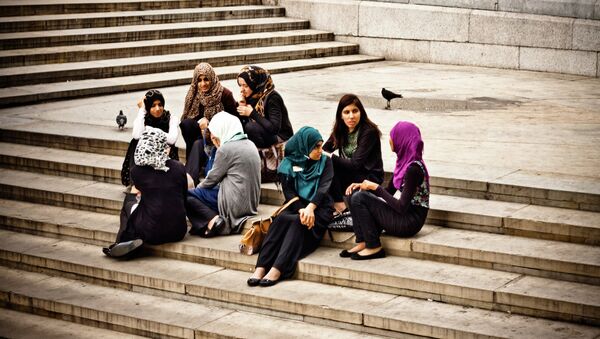From Mipsters (Muslim hipsters) to halal cafes, dating sites and fashion trends, Muslim culture is becoming more visible and accessible to the world.
Who are the Mipsters?
Mipsters are Muslim hipsters in the United States, who have their own Tumblr page and a closed Google group for communication.
The concept began in 2012. In late November, young Muslim women posted a video named “Somewhere in America,” in which models rode skateboards and wore fashionable high heels as well as taking selfies and strolling around fashionable places.
Naturally enough, some of the comments were insulting. Others even tried to remove the clip from the Internet.
“Being a hipster is embarrassing, a Mipster – howling shame.”
However, there were those who stood up for them.
“Modern urban Muslims suffer from the same problems as other ordinary people involved in some activity or movement,” said an expert.
For Shelina Janmohamed the study of Generation M is not just another essay on religion and faith. The author reveals how the young and growing influencers are impacting the wider world.
“It’s a story about a group of young Muslims that span right across the world and they have a really untold story,” Janmohamed told BuzzFeed News.
According to Janmohamed, most Muslims want to claim their rightful place in society and become visible, seen and known for who they are.
Start-ups, fashion and fitness in hijab
An increase in start-ups selling halal products online and in grocery stores has helped Generation M develop their identity.
“Consumption is a real badge of identity for this group – I don’t think we can pretend otherwise. Buying halal products, in the wider sense of the word, is something that has come to define who these people are, so they are seeking out halal products because they want to uphold the principles of their faith,” explained Janmohamed to BuzzFeed News.
The fastest growing economic center is the halal market. The sector’s financial turnover amounts in 2.1 trillion dollars, and is increasing annually by 500 million dollars. According to experts, many global trends still ignore the huge potential of this market.
As for the fashion industry, many brands use women in hijabs to model their line of clothes. A popular British brand Marks & Spencer released a collection of Muslim bathing suits, while H&M featured a model in hijab.
In 2013, Melbourne, Australia, held a Muslim fashion show called 'Faith, Fashion, Fusion: Muslim women's style in Australia' aimed at breaking “ancient” Muslim stereotypes.
Shelina believes that the traditional headdress, covering the woman’s hair and face, often causes misunderstanding. In fact, the hijab, niqab and burqa are forbidden in countries like France and Germany as they go against the government’s view of women’s dignity.
The concept of Muslim beauty is also influenced by Western ideas, which come from the Internet as well as from female role-models. For example, the princess of Saudi Arabia, Deena Abdulaziz Al-Saud, is obviously oriented to the West, while the Western media is focused on the East.
Vogue Arabia will soon be running a feature on the Saudi princess.
In late October, a fitness video Nadoona Extreme, or “Leave it to us”, will be launched. The instructor is a woman wearing hijab and sportswear, completely covering the body.
“Eco-Islam”
Surprisingly enough, Muslims are becoming environmentally aware. While some Muslims buy cow skin for $25,000 dollars, others are more concerned about how the animals lived before they went to slaughter.
The first Islamic community was the Ecology and Environmental Sciences Fund (IFEES). The organization coined the term “eco-jihad,” and encouraged Muslims to clean the streets from debris and even released an Eco-Islam bulletin.
Since 2009, “green Ramadan” has become popular among Muslims in the United States. Muslims eat a specially designed organic halal diet, and redirect surplus food to the starving population in Africa.
Digital environment
According to the author of the book, the availability of information, including religion and education, is becoming an important factor in today’s life.
“I think these are really complicated issues, and that’s also the backdrop of the fact that we have digital space now…You could talk to any Muslim anywhere in the world and realize that you are connecting to their values, and that has really asserted this identity of Generation M,” said Shelina Janmohamed.


